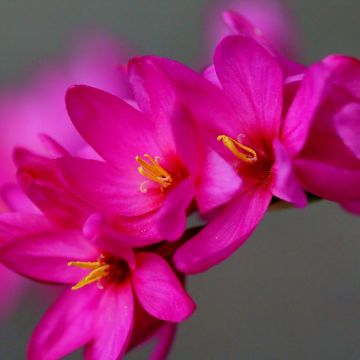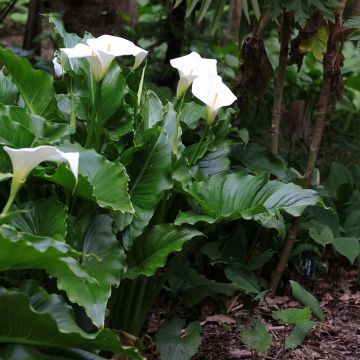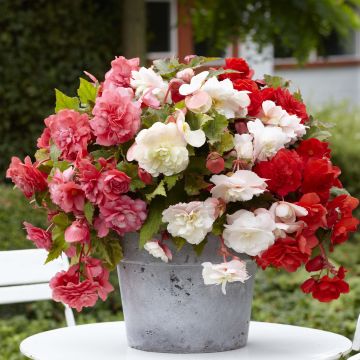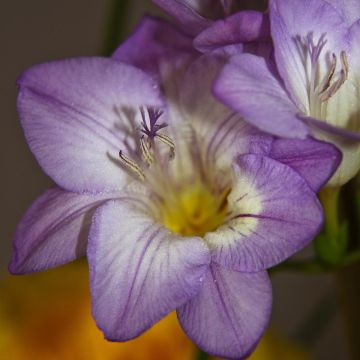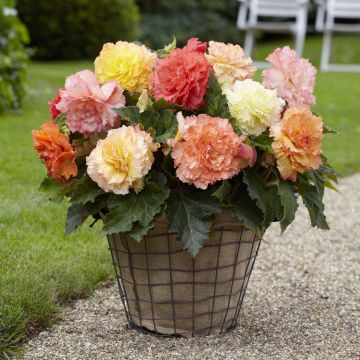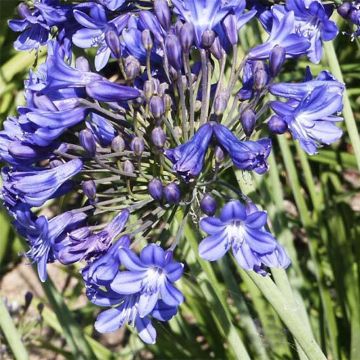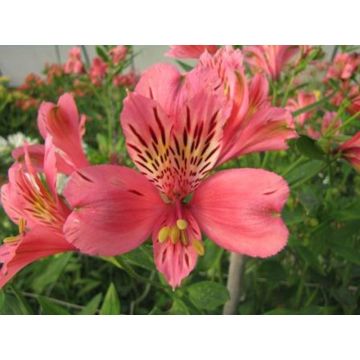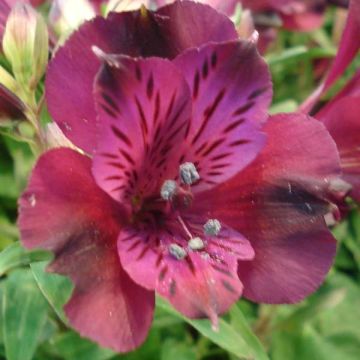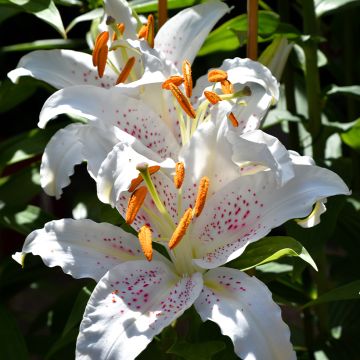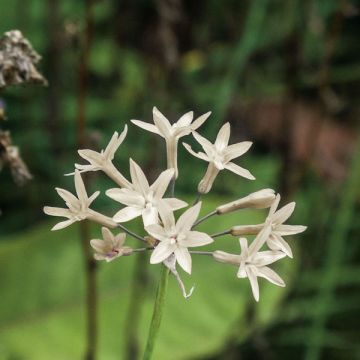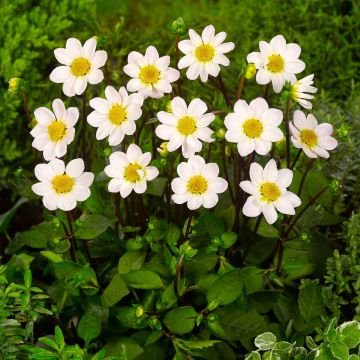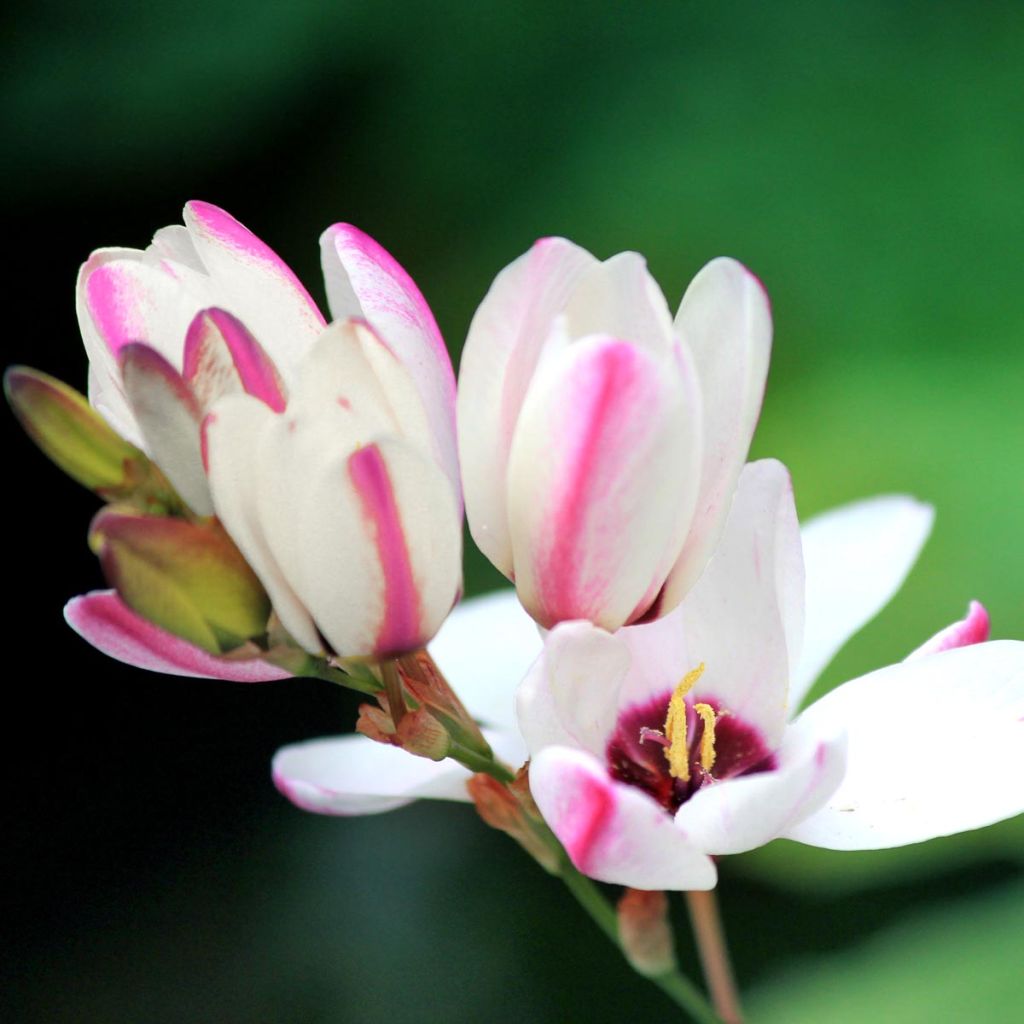

Ixia Spotlight - Lis des Blés
Ixia Spotlight - Corn lily
Ixia Spotlight
Corn Lily, African Corn Lily
Very lovely
Clémentine P., 15/11/2022
This plant carries a 6 months recovery warranty
More information
We guarantee the quality of our plants for a full growing cycle, and will replace at our expense any plant that fails to recover under normal climatic and planting conditions.
From €5.90 for pickup delivery and €6.90 for home delivery
Express home delivery from €8.90.
Does this plant fit my garden?
Set up your Plantfit profile →
Description
Ixia or Corn Lily 'Spotlight' has an abundance of creamy white star-shaped flowers, contrasting with a carmine red central vein on the back of the sepals and a dark purple centre. It is a semi-hardy bulbous plant which is vigorous, sturdy, and very attractive. Suitable for cut flowers as well as for growing in open ground, borders, flower beds, or pots. It is easy to grow and the corms can remain in the ground. It deserves a prominent place in Mediterranean gardens.
Ixias are deciduous perennials with corms, native to South Africa. They are close relatives of Garden Irises and belong to the large family of Iridaceae. The origin of Ixia Spotlight is unknown. In spring, it forms a clump of 6 leaves, usually bright green, long and slender, alternate and sword-shaped. Its growth is rapid. The deciduous foliage disappears in late summer. The thin and rigid, 50 cm (20in) tall flower stems emerge between two fan-shaped leaves in June. Flowering takes place from late June to late August, in the form of spikes of 15 to 20 cup-shaped flowers, 5 cm (2in) in diameter, with a tubular corolla formed by 6 fused tepals. The cream-white sepals are marked on the back with a cardinal red brushstroke in their centre and the heart of the flower is enhanced with a purplish spot and golden stamens. This plant does not produce seeds. The brown and fibrous corm (2.5 cm (1in) in diameter) of this plant is semi-hardy, it withstands moderately cold temperatures (between -5°C (23°F) and -10°C (14°F)).
The flowers of Ixia Spotlight only open when there is sunshine. They should be planted in sunny borders or meadow-like flower beds, except in southern regions where the sun would scorch them, in a light and well-drained soil. They prefer an open, sunny, and protected location. They like well-drained, rocky, or sandy soils, moist in spring and autumn and dry in summer. You can plant them directly in pure sand where their hardiness will be even better. Ixias blend well with late-flowering spring bulbous plants, such as allium giganteum, arum, eremurus, and white lilies. In rockeries, they bring a delicate and shiny note with catmints, Stipa, and pennisetums. They are perfect plants for planters and pots where you can enjoy their magnificent flowering up close while protecting them from strong winter frosts when stored away. Finally, they are excellent flowers for cutting.
Report an error about the product description
Plant habit
Flowering
Foliage
Botanical data
Ixia
Spotlight
Iridaceae
Corn Lily, African Corn Lily
Cultivar or hybrid
Other Ixia
Planting and care
Plant Ixia Spotlight bulbs in autumn, in groups of 8 or 10, spaced in a staggered pattern, in a mixture of sand, leaf compost, and regular soil. The substrate should be permeable and lightweight, but fertile. Planting in the ground in autumn is only possible in regions with mild winters, by protecting the bed with a thick layer of dry leaves. For planting in pots, use the same substrate, adding crushed horn or other organic fertiliser, to support flowering. Shelter the pots from frost and winter rains. As soon as the shoots appear, place the pots in a bright and lightly heated room. Once the risk of frost has passed, place your containers outside in the sun. As the first summer heat arrives, water more generously to support flowering. After flowering, the bulbs should be kept dry until autumn.
Planting period
Intended location
Care
-
, onOrder confirmed
Reply from on Promesse de fleurs
Bulbs to grow in pots
Haven't found what you were looking for?
Hardiness is the lowest winter temperature a plant can endure without suffering serious damage or even dying. However, hardiness is affected by location (a sheltered area, such as a patio), protection (winter cover) and soil type (hardiness is improved by well-drained soil).

Photo Sharing Terms & Conditions
In order to encourage gardeners to interact and share their experiences, Promesse de fleurs offers various media enabling content to be uploaded onto its Site - in particular via the ‘Photo sharing’ module.
The User agrees to refrain from:
- Posting any content that is illegal, prejudicial, insulting, racist, inciteful to hatred, revisionist, contrary to public decency, that infringes on privacy or on the privacy rights of third parties, in particular the publicity rights of persons and goods, intellectual property rights, or the right to privacy.
- Submitting content on behalf of a third party;
- Impersonate the identity of a third party and/or publish any personal information about a third party;
In general, the User undertakes to refrain from any unethical behaviour.
All Content (in particular text, comments, files, images, photos, videos, creative works, etc.), which may be subject to property or intellectual property rights, image or other private rights, shall remain the property of the User, subject to the limited rights granted by the terms of the licence granted by Promesse de fleurs as stated below. Users are at liberty to publish or not to publish such Content on the Site, notably via the ‘Photo Sharing’ facility, and accept that this Content shall be made public and freely accessible, notably on the Internet.
Users further acknowledge, undertake to have ,and guarantee that they hold all necessary rights and permissions to publish such material on the Site, in particular with regard to the legislation in force pertaining to any privacy, property, intellectual property, image, or contractual rights, or rights of any other nature. By publishing such Content on the Site, Users acknowledge accepting full liability as publishers of the Content within the meaning of the law, and grant Promesse de fleurs, free of charge, an inclusive, worldwide licence for the said Content for the entire duration of its publication, including all reproduction, representation, up/downloading, displaying, performing, transmission, and storage rights.
Users also grant permission for their name to be linked to the Content and accept that this link may not always be made available.
By engaging in posting material, Users consent to their Content becoming automatically accessible on the Internet, in particular on other sites and/or blogs and/or web pages of the Promesse de fleurs site, including in particular social pages and the Promesse de fleurs catalogue.
Users may secure the removal of entrusted content free of charge by issuing a simple request via our contact form.
The flowering period indicated on our website applies to countries and regions located in USDA zone 8 (France, the United Kingdom, Ireland, the Netherlands, etc.)
It will vary according to where you live:
- In zones 9 to 10 (Italy, Spain, Greece, etc.), flowering will occur about 2 to 4 weeks earlier.
- In zones 6 to 7 (Germany, Poland, Slovenia, and lower mountainous regions), flowering will be delayed by 2 to 3 weeks.
- In zone 5 (Central Europe, Scandinavia), blooming will be delayed by 3 to 5 weeks.
In temperate climates, pruning of spring-flowering shrubs (forsythia, spireas, etc.) should be done just after flowering.
Pruning of summer-flowering shrubs (Indian Lilac, Perovskia, etc.) can be done in winter or spring.
In cold regions as well as with frost-sensitive plants, avoid pruning too early when severe frosts may still occur.
The planting period indicated on our website applies to countries and regions located in USDA zone 8 (France, United Kingdom, Ireland, Netherlands).
It will vary according to where you live:
- In Mediterranean zones (Marseille, Madrid, Milan, etc.), autumn and winter are the best planting periods.
- In continental zones (Strasbourg, Munich, Vienna, etc.), delay planting by 2 to 3 weeks in spring and bring it forward by 2 to 4 weeks in autumn.
- In mountainous regions (the Alps, Pyrenees, Carpathians, etc.), it is best to plant in late spring (May-June) or late summer (August-September).
The harvesting period indicated on our website applies to countries and regions in USDA zone 8 (France, England, Ireland, the Netherlands).
In colder areas (Scandinavia, Poland, Austria...) fruit and vegetable harvests are likely to be delayed by 3-4 weeks.
In warmer areas (Italy, Spain, Greece, etc.), harvesting will probably take place earlier, depending on weather conditions.
The sowing periods indicated on our website apply to countries and regions within USDA Zone 8 (France, UK, Ireland, Netherlands).
In colder areas (Scandinavia, Poland, Austria...), delay any outdoor sowing by 3-4 weeks, or sow under glass.
In warmer climes (Italy, Spain, Greece, etc.), bring outdoor sowing forward by a few weeks.

































